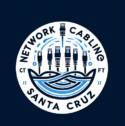How Do You Troubleshoot Cabling Issues? A Complete Step-by-Step Guide
Cabling problems can cause anything from slow internet speeds to complete network outages — and they’re often more common than you think. Whether you’re managing a business network or maintaining a home setup, knowing how to troubleshoot cabling issues can save time, money, and unnecessary frustration.
This guide walks you through how to identify, test, and fix network cabling problems while keeping your system running smoothly and safely. Our team of structured cabling experts in Santa Cruz helps businesses maintain reliable connections and quickly resolve any wiring issues.
Why Cabling Issues Happen
Network cables carry all your data traffic — from video calls and security cameras to POS systems and servers. When something goes wrong, it’s often due to one of the following:
- Loose or damaged connections
- Faulty terminations or crimps
- Broken cables (often caused by bending, pinching, or wear over time)
- Interference from electrical sources or nearby equipment
- Incorrect wiring or pinouts
- Poor-quality materials or installation errors
Understanding the cause is the first step to finding the right fix.
Step-by-Step Process to Troubleshoot Cabling Issues
Here’s a simple, structured process professionals use to locate and fix cabling problems:
1. Start with a Visual Inspection
Before using any tools, look for physical damage. Check cable ends, connectors, and patch panels for visible wear, cuts, or kinks. Make sure each cable is securely plugged in.
Tip: Label your cables during installation — it makes future troubleshooting much easier.
2. Test the Cable Connections
If a device isn’t getting a signal, unplug and reconnect both ends. Swap the cable with one that’s known to work. If the issue disappears, you’ve found your culprit.
3. Use a Cable Tester
A cable tester or network continuity tester helps verify the integrity of your Ethernet cables. It checks for miswiring, open pairs, shorts, or crossed connections.
For advanced diagnostics, a certification tester (like a Fluke DSX series) can measure signal performance, crosstalk, and attenuation — essential for professional environments.
4. Check for Interference or Crosstalk
Electrical noise can disrupt signals in your cabling. Keep data cables at least 12 inches away from power lines, fluorescent lights, and heavy machinery. If interference persists, consider shielded cabling (STP) instead of unshielded (UTP).
5. Inspect the Patch Panel and Wall Jacks
Loose or poorly terminated keystone jacks are common causes of intermittent connectivity. Reseating or re-terminating the cable according to the TIA/EIA 568B wiring standard can often fix the issue.
6. Test Network Devices and Ports
If the cabling checks out, test the switch ports, routers, or NICs (network interface cards). Sometimes, what seems like a wiring issue is actually a hardware fault.
7. Verify Configuration and Network Settings
Don’t overlook software. An incorrect IP configuration, VLAN setup, or disabled port can mimic a cabling problem. Always confirm network settings before replacing cables unnecessarily.
Common Cabling Problems and Quick Fixes
| Problem | Possible Cause | Solution |
|---|---|---|
| No connection | Damaged cable or loose plug | Replace cable or reseat connectors |
| Slow network speed | Interference, wrong cable type | Use Cat6 or higher; reroute away from power |
| Intermittent signal | Poor termination or broken pair | Reterminate or replace affected cable |
| Crosstalk | Unshielded cables near electrical wiring | Switch to STP or separate power and data lines |
| Signal loss over distance | Exceeds 100 meters for copper | Add a switch, extender, or use fiber optics |
Preventing Future Cabling Problems
To reduce future cabling issues, follow these best practices:
- Plan your layout before installation to avoid tight bends or long runs.
- Use high-quality, tested cables that meet industry standards.
- Label every cable and maintain documentation.
- Perform regular cable audits to check wear and connection integrity.
- Hire certified installers for large or complex setups.
Proper maintenance can extend your cabling’s life span and minimize costly downtime.
When to Call a Professional
If you’ve tried basic troubleshooting but the issue persists, it’s time to contact a low-voltage or structured cabling professional. Certified technicians use advanced testing equipment to pinpoint issues hidden inside walls or conduits and ensure your entire network meets TIA and NEC standards.
Professionals also provide documentation and warranties, giving you peace of mind that your cabling system will perform reliably for years. Beyond performance issues, damaged cables can also expose your system to risks. Learn more about how cabling can ensure security in your network infrastructure.
Key Takeaway
Cabling issues might seem intimidating, but most problems have straightforward solutions once you know where to look. From visual inspections to advanced testing, the key is to stay systematic and patient.
If your business or home network still experiences random drops, lag, or connection failures, don’t ignore the signs — it could be a wiring issue affecting your productivity and security.
Contact a certified network cabling expert in California today to ensure your infrastructure is tested, organized, and running at full speed.
